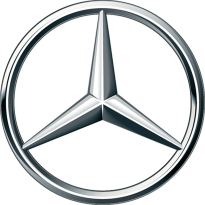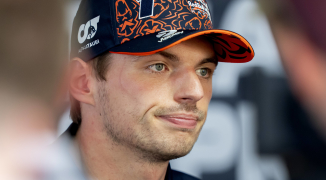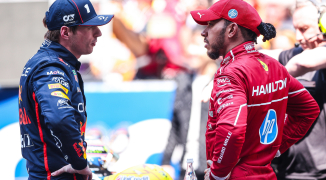Mercedes

Mercedes AMG Petronas F1 Team has been involved in Formula 1 since 2010 as a constructor, competing under the name 'Mercedes GP Petronas F1 Team' in 2010 and 2011.
Since the introduction of the Hybrid V6-Turbo power-units in 2014, the 'Silver Arrows' have been the dominant force in the sport collecting eight constructors' titles along with the seven drivers' titles shared by Lewis Hamilton (six) and Nico Rosberg (one).
But its history in the sport reaches much further than the last decade. As well as competing in two championships in 1954 and 1955, Mercedes-Benz has also supplied engines to Formula 1 teams since 1994, partnering McLaren to a constructors' title in 1998 and Brawn GP to the championship in 2009.
1954-1955: Juan Manuel Fangio takes two titles
In 1954, Mercedes entered Formula 1 at the French Grand Prix as Daimler-Benz AG. Argentine great Juan Manuel Fangio left Maserati in order to drive the Mercedes W196 on its debut outing at Reims.
Much like the car's modern equivalent, the car was technologically ahead of the game and secured instant success. Fangio steered the W196 to victory in four of the six races entered that season, including a 1-2 finish for the team on debut.
For 1955 the same car returned and dominated again, with Fangio taking his second championship with four wins out of the seven championship races that year (including the Indianapolis 500). Not only was the car utterly fast, it had two different specifications to run in.
One was the usual open-wheel configuration we are used to seeing in history books and archive footage. The other is a closed-wheel, streamlined version - coined the 'Type Monza'. To this date, the three victories picked up in that configuration are the only victories by a closed-wheel vehicle in Formula 1.
At the end of the season, the team withdrew from motor racing altogether following the death of Pierre Levegh at Le Mans earlier in the year, not to return to Formula 1 until 1994 in partnership Sauber.
2010-2013: Mercedes and Schumacher return
Daimler AG acquired the Brawn GP team ahead of the 2010 season, following team's success in 2009 against all odds. Ross Brawn stayed on as technical director as the team changed name to Mercedes GP Petronas. Reigning champion Jenson Button left for McLaren and Rubens Barrichello moved to Williams.
The team produced an all-German line-up with Nico Rosberg partnering Michael Schumacher, who came out of retirement to drive for the Silver Arrows.
For the first two seasons, the team finished fourth in the constructors. Only three podiums came in that time - Nico Rosberg finishing third three times in 2010 as he finished with almost double the points tally of Schumacher. Luck rarely fell on Mercedes' side, however. If it had kept raining towards the end of the race at Canada in 2011, for instance, the Schumacher would have probably won the race courtesy of his blistering pace.
In 2012, Rosberg scored the first win of Mercedes' return to Formula 1 in China, a result that could have been even better for the squad had it not been for a problem at Schumacher's pit stop. Schumacher rolled back the years to take pole at Monaco, only to take a penalty for an incident at the Spanish Grand Prix.
Schumacher would retire at the end of the season, after a campaign which yielded only a further two podiums including Schumacher's last in Valencia. Lewis Hamilton surprised many by making the switch from McLaren, who had been championship contenders for over a decade, to Mercedes who had just finished fifth - behind Lotus.
It was to be a year of mixed fortunes for the Silver Arrows. On the one hand, they took three victories, two for Rosberg and one for Hamilton, whilst also picking up enough points to finish second in the standings behind runaway victors Red Bull.
The problem was, it could have been even better. Tyre problems dogged them all season, with one particularly ugly race showing for Hamilton at Barcelona being the low-light of the season. Nevertheless, Mercedes had shown their hand and proved they were serious about their business.
2014-Present: The Hybrid era
When the Formula 1 engine regulations were implemented in 2014, few could have predicted the dominance displayed by Mercedes with the V6 Hybrid-Turbo power units. Ross Brawn left the team at the end of 2013, and under the continued leadership of team principal and CEO Toto Wolff, managing director of Mercedes AMG High-Performance Powertrains Andy Cowell and technical director James Allison, the team has never looked under threat for their championships.
In 2014, not only did the factory team dominate with Hamilton winning all but three of the season's 19 races on his way to his second championship, but the Mercedes engine proved pivotal to Williams' resurgence - the Grove team finishing third in the standings.
2015 saw much of the same for the team. Again, Hamilton and Rosberg secured victories in all but three races. Again, Hamilton was drivers' champion with Mercedes constructors' victors. Again, Williams finished third in the standings aided by Mercedes power, whilst Lotus and Force India also utilised the strength of the power unit to take a podium each.
A year later, the gap between the Mercedes power units compared to the Renault and Ferrari entrants had closed, giving Williams and Force India less of an advantage in their battles with Ferrari and Red Bull.
The only change at the factory team though was which driver would come out on top. Hamilton won ten races to Rosberg's nine but it was Rosberg who prevailed by just five points, with Mercedes again taking the teams' championship by 297 points. Rosberg retired after the season.
Ferrari was much closer to the Silver Arrows in 2017, with Hamilton pushed all the way to the title by Sebastian Vettel. However, the Briton was able to equal Vettel's tally of four championships with nine race wins, whilst new teammate Valtteri Bottas took his first three victories in the sport.
On paper, the field top three were closer still in 2018, with talk of Mercedes' seat on top of the standings being threatened by Ferrari at least. That wasn't to happen though as Hamilton again dominated, taking 11 victories on route to title number five for team and driver. Bottas, however, was winless as the gap between Mercedes and Ferrari closed to less than 100 points.
The closeness wasn't to last as Mercedes returned to dominant ways is 2019. 11 wins for Hamilton and four for Bottas extending the team's monopoly on the sport, wrapping the constructors' title up with four races left to run.
The sixth title meant that Mercedes equalled Ferrari for consecutive constructors' titles won, the Scuderia claiming six-in-a-row between 1999 and 2004.
Mercedes went one better in 2020, harking back to the start of the current formula era by dominating, taking 13 wins from 17 races - 11 for Hamilton.
In the last year of F1's former aerodynamic regulation set, Mercedes were again constructors' champions thanks to the efforts of Hamilton and Bottas.
Red Bull and Verstappen were right with them, however, and for the first time since turbo-hybrids were introduced, the Silver Arrows failed to complete the championship double, with the Dutchman defeating Hamilton in the final round of the year.
Bottas left the team at the end of 2021 to be replaced by George Russell.
The 2022 season proved to be a challenging one for the Mercedes team as they struggled to keep up with the blistering pace set by Red Bull.
Despite their best efforts, they only managed to secure a single victory in Sao Paulo by their new driver, George Russell.
Meanwhile, Lewis Hamilton experienced a season like no other, failing to win a single race throughout the entire campaign for the first time in his illustrious F1 career.
As the season came to an end, Mercedes found themselves in third place in the constructors' championship, with Hamilton finishing in sixth place and Russell in fourth in the drivers' standings.
Moving into the 2023 season, Mercedes were in a fierce battle with Ferrari to secure the second spot in the constructors' championship.
It all came down to the final round in Abu Dhabi, where the team managed to secure the position with a total of 409 points—a mere three points ahead of the Scuderia.
Hamilton finished the season with six podium finishes and a respectable third place with a total of 234 points, while Russell ended the campaign with two podiums and finished eighth with 175 points.























 Grand Prix of Australia 2025
Grand Prix of Australia 2025  Grand Prix of China 2025
Grand Prix of China 2025  Grand Prix of Japan 2025
Grand Prix of Japan 2025  Grand Prix of Bahrain 2025
Grand Prix of Bahrain 2025  Saudi Arabian Grand Prix 2025
Saudi Arabian Grand Prix 2025  Grand Prix De Monaco 2025
Grand Prix De Monaco 2025  Gran Premio de España 2025
Gran Premio de España 2025  Grand Prix du Canada 2025
Grand Prix du Canada 2025  Grand Prix of Austria 2025
Grand Prix of Austria 2025  Grand Prix of Belgium 2025
Grand Prix of Belgium 2025  Grand Prix of Hungary 2025
Grand Prix of Hungary 2025  Grand Prix of Azerbaijan 2025
Grand Prix of Azerbaijan 2025  Grand Prix of Singapore 2025
Grand Prix of Singapore 2025  Gran Premio de la Ciudad de Mexico 2025
Gran Premio de la Ciudad de Mexico 2025  Grande Prêmio de São Paulo 2025
Grande Prêmio de São Paulo 2025  Qatar Grand Prix 2025
Qatar Grand Prix 2025  Grand Prix of Abu Dhabi 2025
Grand Prix of Abu Dhabi 2025 